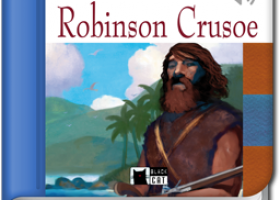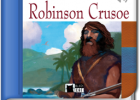Robinson Crusoe
A. About the Author
1. Robinson goes to sea
D. The Atlantic Slave Trade
P. Project on the web (I)
2. The Island
P. Project on the web (II)
3. King of the Island
4. Footprints
D. The real Robinson Crusoe: Alexander Selkirk
5. Friday
6. Back Home
A. After Reading
P. Project on the web (III)
Este libro contiene:
-
13 secuencias
-
73 recursos
-
Idioma:
- Inglés
Libro de texto
-
1. About the Author
- Ir a ficha de secuencia
- 0 secuencias
- 2 recursos
Daniel Defoe was born in London in 1660. His parents were very religious and his father wanted him to become a minister in the Church but Daniel became a merchant, selling and buying wines and other goods. In 1719, he published Robinson Crusoe, his most successful novel. It was based partly on the memoirs of Alexander Selkirk (see page 57). [...]
-
2. Robinson goes to sea
- Ir a ficha de secuencia
- 0 secuencias
- 12 recursos
Robinson goes to sea
-
3. The Atlantic Slave Trade
- Ir a ficha de secuencia
- 0 secuencias
- 2 recursos
In chapter one, Robinson becomes a slave and he also meets an African slave – Xury. At the time that Defoe wrote Robinson Crusoe the slave trade1 was an enormous business, which made a lot of money. But what is the history of the Atlantic slave trade? The Atlantic slave trade began in the 15th century when the Portuguese started taking people from the west coast of Africa to Brazil. [...]
-
4. Project on the web (I)
- Ir a ficha de secuencia
- 0 secuencias
- 1 recurso
Connect to the Internet and go to: www.blackcat.vicensvives.net. Insert the title or part of the title of the book into our search engine. Open the page for Robinson Crusoe. Click on the Internet project link for slavery. Scroll down the page to ‘Slave System’ or ‘Slave Life’ and choose one aspect of slavery to find out more about. Tell your class about it.
-
5. The Island
- Ir a ficha de secuencia
- 0 secuencias
- 10 recursos
The Island
-
6. Project on the web (II)
- Ir a ficha de secuencia
- 0 secuencias
- 1 recurso
Nowadays a lot of people keep diaries but they don’t keep them in a book. They have got a blog online and write down a lot of information about themselves there. Millions of people can see this information! Connect to the Internet and go to www.blackcat.vicensvives.net. Insert the title or part of the title of the book into our search engine. Open the page for Robinson Crusoe. Click on the internet project link for creating your own blog. [...]
-
7. King of the Island
- Ir a ficha de secuencia
- 0 secuencias
- 9 recursos
King of the Island
-
8. Footprints
- Ir a ficha de secuencia
- 0 secuencias
- 11 recursos
Footprints
-
9. The real Robinson Crusoe: Alexander Selkirk
- Ir a ficha de secuencia
- 0 secuencias
- 4 recursos
A lot of people believe that Daniel Defoe took the idea for his novel Robinson Crusoe from the true-life adventures of Alexander Selkirk, a sailor who was left alone on an island for four years and four months. Selkirk was born in Fife, Scotland, in 1676 and was the seventh son of a shoe maker. He went away to sea when he was about 19, and in 1703 joined the expedition of the famous privateer and explorer William Dampier. [...]
-
10. Friday
- Ir a ficha de secuencia
- 0 secuencias
- 8 recursos
Friday
-
11. Back Home
- Ir a ficha de secuencia
- 0 secuencias
- 9 recursos
Back Home
-
12. After Reading
- Ir a ficha de secuencia
- 0 secuencias
- 3 recursos
After Reading
-
13. Project on the web (III)
- Ir a ficha de secuencia
- 0 secuencias
- 1 recurso
There are many films based on Defoe’s story of Robinson Crusoe. Here are some of them: The Adventures of Robinson Crusoe (1922) Robinson Crusoe (1946) The Adventures of Robinson Crusoe (1954) Man Friday (1975) Robinson Crusoe (1997) Find out more about the films. Connect to the Internet and go to www.blackcat.vicensvives.net . Insert the title or part of the title of the book into our search engine. Open the page for Robinson Crusoe. [...]
-
Aún no hay comentarios, ¡comparte tu opinión! Inicia sesión o Únete a Tiching para poder comentar
La licencia digital es una autorización que permite utilizar un recurso digital de acuerdo con las condiciones legales de dicho recurso. El código que recibas una vez la hayas comprado te permitirá acceder al recurso educativo digital elegido.
Puedes consultar más información en nuestra página de ayuda.






¿Dónde quieres compartirlo?
¿Quieres copiar el enlace?